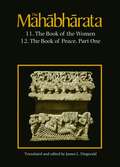- Table View
- List View
Sanskrit Semester 1 class 8 - GSTB: संस्कृत (प्रथम सत्र ) कक्षा ८
by Narendra Rawal Kanubhai Karkar Aita Parmar Troubled Thackerપ્રસ્તુત પાઠ્યપુસ્તક માં ચિત્રપદાની 1 અને 2 માં ચિત્રો ના મળ્યાં થી દુર અને નજીક ની વાત કહેતી વખતે સંસ્કૃત માં ક્યાં શબ્દો નો ઉપયોગ કરવો તે સમજવામાં આવેલ છે . आत्मश्रद्धायाः प्रभावः પાઠ માં એકલવ્ય ની વાર્તા સમજવામાં આવી છે. एहि सुधीर કવિતા जनार्दन हेगडे ની લેવામાં આવી છે. शीलायाः प्रवासः જેમાં પ્રવાસ વર્ણન કરેલ છે સાથે ગુફાઓ વિષે અને શીલાઓ વિષે માહિતી આપેલ છે. विनोदपद्यानि માં હાસ્ય વિનોદની ની વાતો છે. सङ्ख्या પાઠ માં ફળો વિષે માહિતી આપેલ છે. અને પુનરાવતન 1 અને 2 આપેલ છે.
Sanskrit class 9 - GSTB: સંસ્કૃત ધોરણ ૯
by Shri Maharudra K. Sharma Kamlesh Chokshi. Mansukh Molia Mohini Dave Smitabhain Joshiઆ પાઠ્યપુસ્તકમાં સંસ્કૃતના ભાષાકીય, સાહિત્યિક તેમજસાંસ્કૃતિક વૈવિધ્યને લક્ષ્યમાં લીધેલું છે. જરૂર જણાય ત્યાં વિદ્યાર્થીઓની વયકક્ષાને અનુરૂપ કેટલાંક સંપાદન તેમજ સ્વતંત્ર પાઠની સંરચના કરવામાં આવી છે. સંસ્કૃત સંભાષણનાં પાસાંને આવરી લેવાયાં છે. સંસ્કૃત ભાષાનો સઘન પરિચય થાય તે માટે સઘળાં પદોની વિસ્તૃત સમજૂતી અપાઈ છે. સંસ્કૃત સાહિત્યનાં વિવિધ સ્વરૂપોને અહીં પ્રતિનિધિત્વ અપાયું છે. પ્રસ્તુત પાઠ્યપુસ્તક દ્વારા વિદ્યાર્થીઓમાં સર્જનાત્મકતા, વિચારશક્તિ અને તર્કશક્તિ વિકસે અને તે દ્વારા સર્વાગી વિકાસ થાય તેમજ અધ્યયન અધ્યાપન પ્રક્રિયામાં મદદરૂપથાય તે રીતે પાઠ્યપુસ્તક તૈયાર કરવામાં આવ્યું છે.
The Mahabharata, Volume 7: Book 11: The Book of the Women Book 12: The Book of Peace, Part 1
What is found in this epic may be elsewhere; What is not in this epic is nowhere else. —from The Mahabharata The second longest poem in world literature, The Mahabharata is an epic tale, replete with legends, romances, theology, and metaphysical doctrine written in Sanskrit. One of the foundational elements in Hindu culture, this great work consists of nearly 75,000 stanzas in eighteen books, and this volume marks the much anticipated resumption of its first complete modern English translation. With the first three volumes, the late J. A. B. van Buitenen had taken his translation up to the threshold of the great war that is central to the epic. Now James Fitzgerald resumes this work with translations of the books that chronicle the wars aftermath: The Book of Women and part one of The Book of Peace. These books constitute volume 7 of the projected ten-volume edition. Volumes 4, 5, 6, 8, 9, and 10 of the series will be published over the next several years. In his introductions to these books, Fitzgerald examines the rhetoric of The Mahabharatas representations of the wars aftermath. Indeed, the theme of The Book of Women is the grief of the women left by warriors slain in battle. The book details the keening of palace ladies as they see their dead husbands and sons, and it culminates in a mass cremation where the womens tears turn into soothing libations that help wash the deaths away. Fitzgerald shows that the portrayal of the womens grief is much more than a sympathetic portrait of the sufferings of war. The scenes of mourning in The Book of Women lead into a crisis of conscience that is central to The Book of Peace and, Fitzgerald argues, the entire Mahabharata. In this book, the man who has won power in the great war is torn between his own sense of guilt and remorse and the obligation to rule which ultimately he is persuaded to embrace. The Mahabharata is a powerful work that has inspired awe and wonder for centuries. With a penetrating glimpse into the trauma of war, this volume offers two of its most timely and unforgettable chapters.

